Bulgogi beef is a classic dish in Korea made with marinated beef, sliced ultra-thin and then grilled or stir fried. Although it is widely available in restaurants and small eateries, it is deeply ingrained as a home dish, a comfort food if you will.
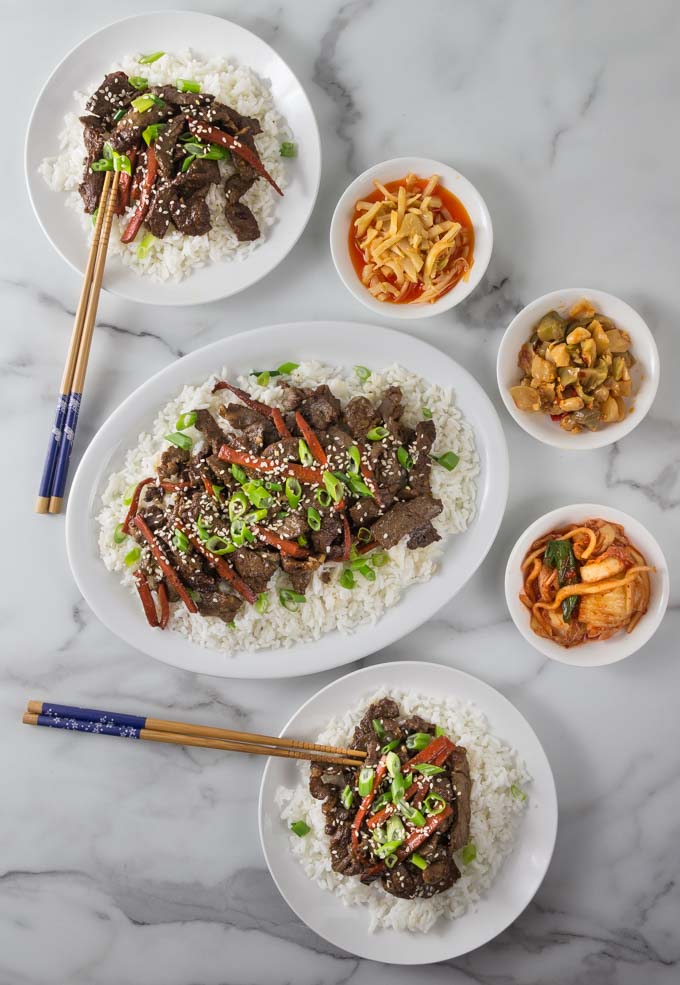
What is bulgogi?
History goes that this dish dates back to the Goguryeo era (37 B.C. to 668 A.D.), when it was called maekjeok and served on skewers like a kebab. Over time, the cooking methods changed. By the early 20th century, beef bulgogi had become a high-end treat. Kebab-style skewers had given way to thinly sliced cuts and the dish was now considered luxurious, mostly eaten by the nobility.
The bulgogi recipe we know today made its way to America during the Korean immigration in the late 19th century. Keep in mind, every cook is going to have their own spin on the dish and might modify based on local ingredients. The results remain about the same though: tender, flavorful grilled beef that can be enjoyed wrapped in lettuce leaves with kimchi or served alongside rice and vegetables.
Bulgogi beef translates literally to "fire meat." Why is this? It was originally grilled directly over a charcoal fire. The dish is actually native to the Pyongan Province of North Korea. After the Japanese left the area in 1945, the dish spread in popularity to Seoul and other parts of South Korea.
Korean Food is Healthy
Which brings me to my next point about Korean food: It is extremely healthy. The most common ingredients are vegetables. There is always a mix of fresh, stir fried and fermented vegetables at the table. These pack nutrients that are released from cooking or pickling. Did you know there are hundreds of different kimchi recipes in Korean cuisine? They're made for specific seasons and all distinctly different from one another. Fascinating!
Soup or broth is also served with almost every meal. It is satisfying and helps fill you up without the extra calories. It's both a palate cleanser and also very soothing to sip on before the main meal. Often it is a bone broth or a fish-based broth garnished with chives. Unlike Western cuisine, meat is more of a condiment than a main feature. Meat is high in calories and saturated fats (depending on whether it's pork, beef, or poultry.) Less meat in the dishes makes caloric intake lower and places focus on essential nutrients. Finally, tea is often consumed with the meal which aids digestion and is rich in antioxidants.
When my daughter came home from Asia she of course applauded all of the health benefits of the Eastern way of enjoying a meal. She immediately started pickling vegetables on every open kitchen shelf and became somewhat of a tea connoisseur.
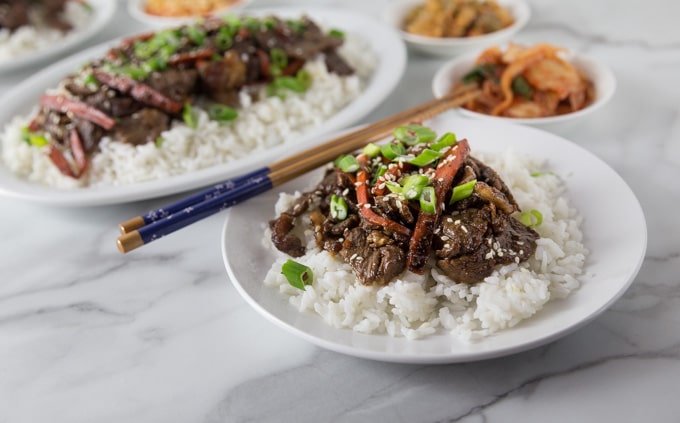
Making Beef Bulgogi
Now it's time to make your bulgogi. The traditional recipes will call for sirloin, ribeye, or other prime cuts of beef. Why is this? These cuts of meat are naturally more tender and easy to cut for the prep work. If you don't have beef on hand, chicken or pork will do.
Traditionally, it is grilled. You can cook it on a pan though if you have limited time or don't own a grill. The marinade is typically made of a blend of soy sauce, sugar, sesame oil, garlic, black pepper, apple or pear, scallions, ginger, onions, and mushrooms. Keep in mind, this can vary chef to chef and family to family. Some people will marinate it only for a few hours where others will let the flavors soak in overnight. The choice is yours. I like to marinate mine covered in the fridge for about 2-4 hours.
The key is to slice the meat as thin as possible. If you don't have a super sharp knife or are concerned about your cutting skills, throw the meat in the freezer for 1.5-2 hours and it will be much easier. Make sure to wrap each piece in plastic wrap to avoid freezer burn. If you're still having trouble slicing the meat, pop it back in the freezer for another 30 minutes. I also highly recommend that you sharpen your knife before starting out.
Slice the meat against the grain so it is tender. If you slice against it, your meat could turn out chewy. This is because when you slice against it, the fibers are shorter. This was a cooking tip I learned later in life and WOW. What a difference it makes.
Now why did we include fruit or a certain vegetables in the marinade? Pears, apples and ginger are a natural meat tenderizer and add a hint of flavor. These raw elements contain enzymes that will break down proteins. Proteins are made of amino acids that make larger molecules. Enter enzymes and we have something that starts to break these apart. Some people will use kiwi or pineapple but be warned: these fruits are much more acidic and you'll need to follow a "less is more" approach. The meat can change in color and texture to a point where it won't be as delicious. Yikes!
Step by step photos:
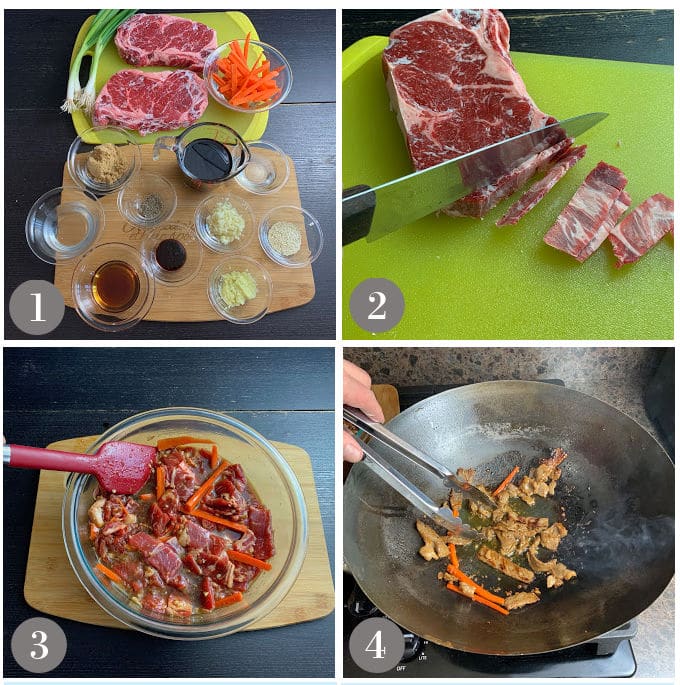
- Before you start, place the beef in the freezer until it is very firm, around 2 hours typically works well depending in the thickness. While your beef is firming up in the freezer gather all your ingredients and have them measured, chopped and ready to go.
- Slice the frozen beef into the thinest strips possible and place them in a large bowl.
- Add the soy sauce, brown sugar, sesame oil, minced garlic, grated ginger, black pepper, mirin rice wine
, carrots and about 3 tablespoons of water or just enough to cover all the beef. Stir very well for a minute or two to combine. Cover with plastic wrap and refrigerate for at least two hours.
- You can grill the beef quickly or I like to make indoors in a very hot wok. Work in small batches and allow all the juice to evaporate while cooking and the beef will get a nice brown caramelization. Set aside the cooked beef and cook another batch. Serve with rice and garnish with sesame seeds and slices of green onion.
Pro tips
If you want a smokey flavor but don't have a grill, use a well-seasoned cast iron skillet.
Don't crowd the pan. If you put too much of your sliced beef in at once, the juices that are released won't evaporate and this changes the texture of the dish.
Get the skillet HOT before adding the beef. This will get you nice caramelization.
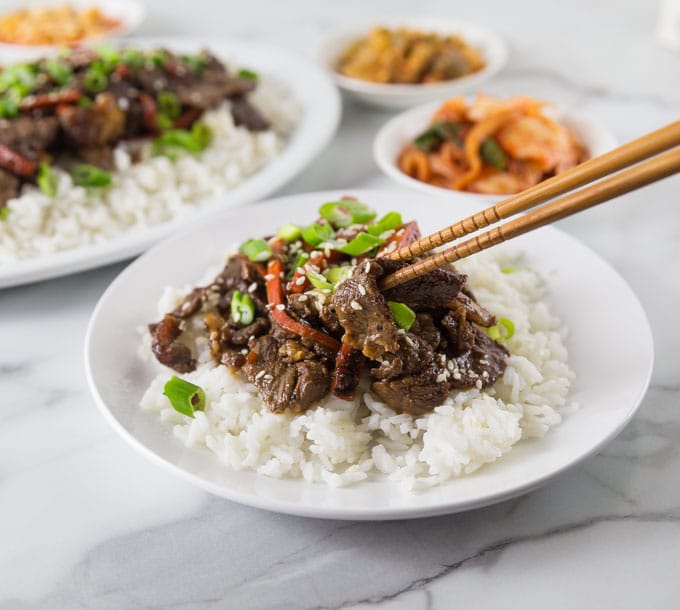
Serving Beef Bulgogi
Korean food is all about balance. Like I said before, the meat won't be the main feature of the dish. You can serve your bulgogi beef with steamed rice, kimchi, broth, and stir fried vegetables. If you don't want to have it with rice, bring some lettuce leaves to the table. Place a slice or two of bulgogi beef in the lettuce leaf with a piece of kimchi and make a small wrap.
The kimchi is also meant to aid digestion and balance out the sweet and savory taste of the beef bulgogi.
Frequently asked questions:
- How long can I store the cooked bulgogi in the refrigerator? Once the beef has cooled you can store it in the refrigerator in an airtight container for 3-4 days.
- How do I reheat the bulgogi? Reheat the bulgogi in the microwave for 2-3 minutes and stop to stir every 30-45 seconds until hot. Once reheated do not cool and store again in the refrigerator, consume it right away. So only reheat the amount you will consume.
- Can I freeze the bulgogi? Yes, allow the beef to cool and you can freeze in airtight containers for up to 2 months. Thaw completely in the refrigerator and then reheat in the microwave.
Looking for more recipes?
Sign up for my free recipe newsletter to get new recipes in your inbox each week! You can also find me sharing more inspiration in Pinterest and Facebook
📖 Recipe
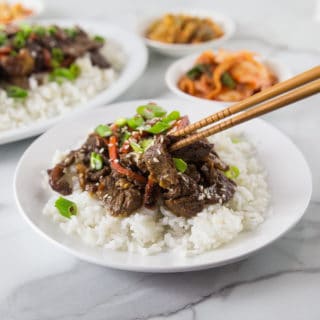
Bulgogi Beef Recipe
Ingredients
- 1.5 lbs beef ribeye or strip works nicely
Marinade:
- ½ cup soy sauce
- 3 tablespoon brown sugar
- 3 cloves garlic minced
- 1 tablespoon ginger fresh grated
- ½ teaspoon black pepper
- 2 tablespoon mirin rice wine (not rice vinegar)
- 1 carrot sliced into strips
- 3 tablespoon water
Garnish:
- 3 green onions greens only chopped
- 1 tablespoon sesame seeds
Instructions
- Freeze the beef until it is very firm. About 2 hours works to get it firm depending on the thickness.
- While the beef is freezing mince the garlic, grate the ginger, peel and slice the carrots into strips. Measure out the rest of the ingredients for the marinade.
- Slice the frozen beef into the thinest strips possible and place in a bowl.
- Add the marinade ingredients to the beef and stir for a minute or two until it is well combined. Add just enough water so the beef is completely covered. Wrap the bowl with plastic to cover and refrigerate for about 2 hours.
- You can grill the beef quickly or I like to make indoors in a very hot wok. Work in small batches and allow all the juice to evaporate while cooking and the beef will get a nice brown caramelization. Set aside the cooked beef and cook another batch.
- Serve with rice and garnish with sesame seeds and slices of green onion. Another option is to wrap the beef in lettuce or serve over rice noodles.


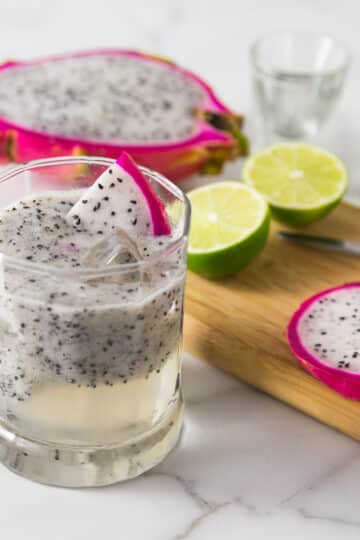
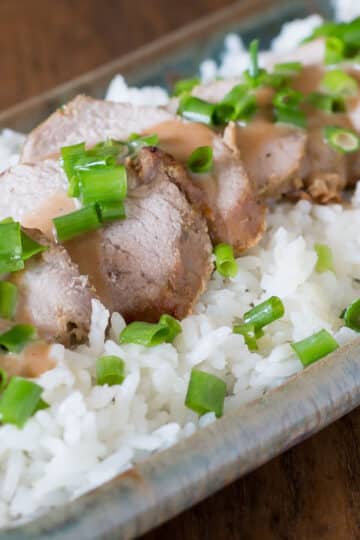
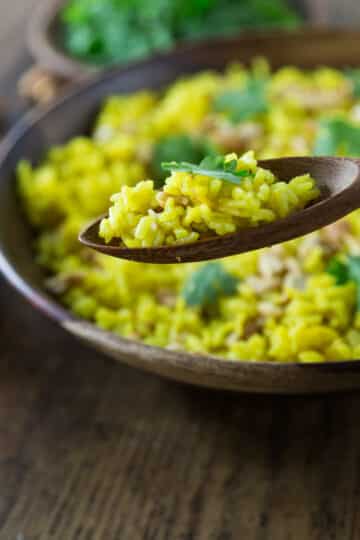
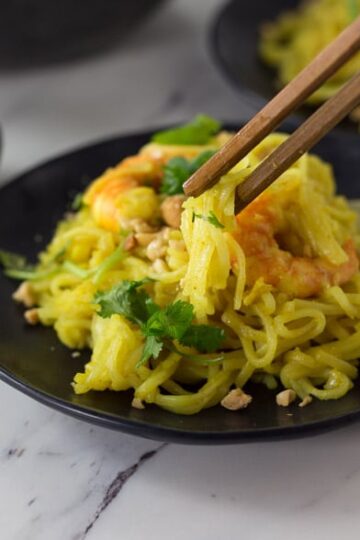
Leave a Reply